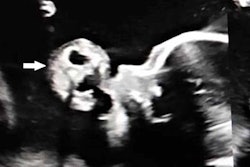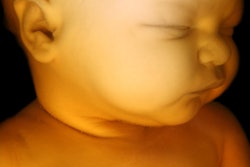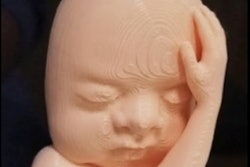
The benefits of using third-trimester ultrasound scans to predict large infant size may be limited, according to a review published online October 13 in PLOS Medicine. Ultrasound size estimates failed to reliably predict one of the most common complications of delivering large newborns.
Shoulder dystocia is a major perinatal complication associated with macrosomia, a term used to describe infants typically weighing more than 8 lb 13 oz at birth. In an ideal screening program, ultrasound scans would both identify large infants and prevent shoulder dystocia and other size-related perinatal complications.
But the new systematic review of 112,000 pregnancies casts doubt on ultrasound's predictive ability for low- and medium-risk pregnancies. A U.K.-based team found prenatal ultrasound screening correctly identified many cases of macrosomia but only had a weak association with predicting shoulder dystocia.
"There is a debate regarding introducing universal third-trimester screening for macrosomia," wrote the authors, led by Dr. Alexandros Moraitis, an obstetrics and gynecology trainee at the University of Cambridge. "An effective screening program requires two elements: an effective test at predicting a condition and an effective intervention."
The review included 41 studies evaluating the prediction ability of size measurements derived from ultrasound scans performed after 24 weeks of pregnancy. The team specifically excluded studies on high-risk pregnancies, since they are the focus of an ongoing randomized clinical trial in the U.K.
Ultrasound size measurements reliably indicated which infants would have macrosomic birth weights for women with low-risk and mixed-risk pregnancies. The results stayed consistent whether studies calculated birth size by abdominal circumference or estimated fetal weight (EFW) techniques.
| Ability of high estimated fetal weight on ultrasound to predict perinatal outcomes | |||
| Birth weight 90+ percentile | Birth weight 97+ percentile | Shoulder dystocia | |
| No. of patients | 80,045 | 51,686 | 26,264 |
| Sensitivity | 53.2% | 67.5% | 22% |
| Specificity | 93.9% | 89.7% | 89.6% |
The authors also found a significant relationship between large ultrasound size measurements and the occurrence of shoulder dystocia. But they cautioned that the relationship was weak, with large EFW on ultrasound tied to just a 15% greater probability of shoulder dystocia.
"The fact that ultrasonic EFW is relatively poor as a predictor of shoulder dystocia is not unexpected, given that the actual birth weight of the baby is also not a strong predictor of the outcome: The majority of cases of shoulder dystocia involve a normal birth weight infant," the authors wrote.
One of the biggest drawbacks of the review was the quality of the included studies. The studies had largely heterogeneous designs and many were unblinded. In fact, unblinded studies showed a greater association between ultrasound weight predictions and shoulder dystocia than blinded ones, suggesting the presence of bias.
Furthermore, few studies looked at the association between ultrasound-based size predictions and neonatal morbidity. Of the few that did, the researchers found no association between macrosomia prediction and neonatal unit admission.
The authors called on future researchers to study whether other factors can help identify pregnancies most at risk for complications. In the meantime, they can't recommend universal screening for macrosomia -- especially because other studies have found that wrong size predictions can lead to unnecessary caesarean sections.
"We recommend caution prior to introducing universal third-trimester screening for macrosomia, as it would increase the rates of intervention, with potential iatrogenic harm, without clear evidence that it would reduce neonatal morbidity," they wrote.



















